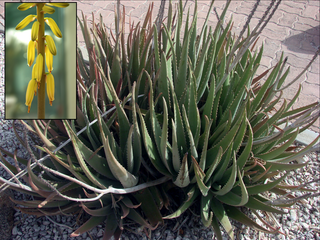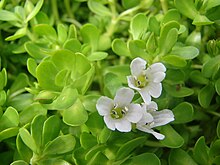
Basil, also called great basil, is a culinary herb of the family Lamiaceae (mints). It is a tender plant, and is used in cuisines worldwide. In Western cuisine, the generic term "basil" refers to the variety also known as sweet basil or Genovese basil. Basil is native to tropical regions from Central Africa to Southeast Asia. In temperate climates basil is treated as an annual plant, however, basil can be grown as a short-lived perennial or biennial in warmer horticultural zones with tropical or Mediterranean climates.

Zygophyllaceae is a family of flowering plants that contains the bean-caper and caltrop. The family includes around 285 species in 22 genera.

In botany, a perennial plant or simply perennial is a plant that lives more than two years. The term is often used to differentiate a plant from shorter-lived annuals and biennials. The term is also widely used to distinguish plants with little or no woody growth from trees and shrubs, which are also technically perennials. Notably, it is estimated that 94% of plant species fall under the category of perennials, underscoring the prevalence of plants with lifespans exceeding two years in the botanical world.

Harpagophytum, also called grapple plant, wood spider, and most commonly devil's claw, is a genus of plants in the sesame family, native to southern Africa. Plants of the genus owe their common name "devil's claw" to the peculiar appearance of their hooked fruit. Several species of North American plants in the genus Proboscidea and certain species of Pisonia, however, are also known by this name. Devil's claw's tuberous roots are used in folk medicine to reduce pain.

Aloe vera is a succulent plant species of the genus Aloe. It is widely distributed, and is considered an invasive species in many world regions.

Leaf vegetables, also called leafy greens, pot herbs, vegetable greens, or simply greens, are plant leaves eaten as a vegetable, sometimes accompanied by tender petioles and shoots. Leaf vegetables eaten raw in a salad can be called salad greens.

Bacopa monnieri is a perennial, creeping herb native to the wetlands of southern and Eastern India, Australia, Europe, Africa, Asia, and North and South America. It is known by the common names water hyssop, waterhyssop, brahmi, thyme-leafed gratiola, herb of grace, and Indian pennywort. Bacopa monnieri is used in Ayurveda. In 2019, the US Food and Drug Administration (FDA) warned manufacturers of dietary supplement products containing Bacopa monnieri against making illegal and unproven claims that the herb can treat various diseases.

Withania somnifera, known commonly as ashwagandha or winter cherry, is an evergreen shrub in the Solanaceae or nightshade family that grows in India, the Middle East, and parts of Africa. Several other species in the genus Withania are morphologically similar.

Bacopa caroliniana is a flowering plant species.

Anartia jatrophae, the white peacock, is a species of butterfly found in the southeastern United States, Central America, and throughout much of South America. The white peacock's larval hosts are water hyssop, lemon bacopa, tropical waterhyssop, frogfruit, lanceleaf frogfruit, and Carolina wild petunia . The males of the species display a unique territorial behavior, in which they stake out a territory typically 15 meters in diameter that contains larval host plants. They perch in this area and aggressively protect it from other insects and other male white peacocks.

Azolla filiculoides is a species of aquatic fern. It is native to warm temperate and tropical regions of the Americas, and has been introduced to Europe, North and sub-Saharan Africa, China, Japan, New Zealand, Australia, the Caribbean and Hawaii.

Cuphea hyssopifolia, the false heather, Mexican heather, Hawaiian heather or elfin herb, is a small evergreen shrub native to Mexico, Guatemala, and Honduras.

Tetrachondraceae is a plant family in the order Lamiales. The family contains the two genera Polypremum and Tetrachondra, which together comprise the three species:

Polypremum is a flowering plant genus in the family Tetrachondraceae. The genus contains the single species Polypremum procumbens, commonly known as juniperleaf or rustweed. Polypremum has also been placed in the various families Buddlejaceae, Loganiaceae, Rubiaceae, and most recently in its own Polypremaceae.
Cnidium monnieri (L.) Cusson ex Juss., Monnier's snowparsley, is a flowering plant species in the genus Cnidium. Also known as Shechuangzi, Osthole, Jashoshi, Cnidii Fructus . It may be confused with Bacopa monnieri, Ligusticum officinale, both similar but different plants. The coumarins osthol, imperatorin and xanthotoxol can be found in C. monnieri.

Alysicarpus vaginalis is a species of flowering plant in the legume family, Fabaceae. It is native to parts of Africa and Asia, and it has been introduced to other continents, such as Australia and the Americas. It is cultivated as a fodder for livestock, for erosion control, and as a green manure. Common names include alyce clover, buffalo clover, buffalo-bur, one-leaf clover, and white moneywort.

Bacoside A is a mixture of chemical compounds, known as bacosides, isolated from Bacopa monnieri. Its major constituents include the saponins bacoside A3, bacopaside II, jujubogenin isomer of bacopasaponin C, and bacopasaponin C. The mixture has been studied in in vitro experiments and animal models for its potential neuroprotectivity.
Mohan Mishra was an Indian physician, known for his studies on Visceral leishmaniasis, and its treatment using Amphotericin B, regarded by many as a pioneering attempt. The Government of India honoured him, in 2014, with the award of Padma Shri, the fourth highest civilian award, for his contributions to the fields of medicine.
Clinical trials on ayurveda refers to any clinical trials done on ayurvedic treatment. Ayurveda is a traditional medicine system in India and like other cultural medical practices includes both conventional medicine and also complementary and alternative medicine. When there are clinical trials in ayurveda, the focus tends to be on practices in alternative medicine.


















